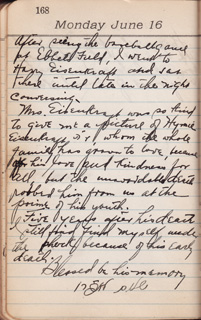
After seeing the baseball game
at Ebbets Field, I went to
Harry Eisenkraft and sat
there until late in the night
conversing.
Ms. Eisenkraft was so kind
to give me a picture of Hymie
Eisencraft (Olam Haba) whom the whole
family has grown to love, because
of his love and kindness for
all, but the unavoidable death
robbed him from us at the
prime of his youth.
Five years after his death
I still find find myself under
the shock because of his early
death.
Blessed be his memory
Shalom [?]
Matt’s Notes
Not a bad day to be at Ebbet’s Field, where the Robins (a.k.a. Dodgers) beat the Cincinnati Reds, 5-2.

I’m not sure who the beloved Hymie Eisencraft was, but Papa must have really felt strongly for him to honor him with the term “Olama Haba” (“I’ll see him in the afterlife”) that he has previously used only in relation to his recently-departed father.
Papa also concludes the entry with another Hebrew tribute, though it’s a bit hard to read. My Hebrew-reading wife, Stephanie, can tell it starts with the word “Shalom,” but the second word is harder to make out. Any ideas?


Update: My friend Inbar, a native Hebrew speaker, thinks this is Shalom Lefro, literally “Goodbye to his ashes.”
—————
Update 10/17/07 – I now have a photo of Hymie Eisenkraft:


This photo comes to me through the grandson of the above-mentioned Harry Eisenkraft, who read about this blog in the October 14th New York Times City section. Papa’s father was likely the brother of Harry’s mother, Sara, who spelled her last name Seuerman (making Papa and Harry cousins). Though Hymie fought in World War I, his untimely death did not come in the trenches; he was killed by an auto in Brooklyn on June 26, 1919, an ironic fate too good for the front page editors of the Brooklyn Eagle to pass up.
The woman Hymie appears with in the photo above is his sister-in-law, Jennie. She was married to Harry and appears with him in the photo below.


Harry had one other brother, Issac Mendel, who Papa mentions in his May 15th entry.
—————
Update 1/11/08
Here’s another picture of Hymie Eisenkraft in the form of a custom-made Rosh Hashanah card:

I’ve written a bit more about this card in a separate post.
—————
References for this post:
ROBINS BEAT RIXEY AND THE REDS, 5-2; Brooklyn Batters Rout Western Invaders With Four-Run Rally in the Eighth. The New York Times, June 17, 1924.
Image Source: Outside Ebbet’s Field, 1920. Library of Congress # LC-B2- 5311-1 .

